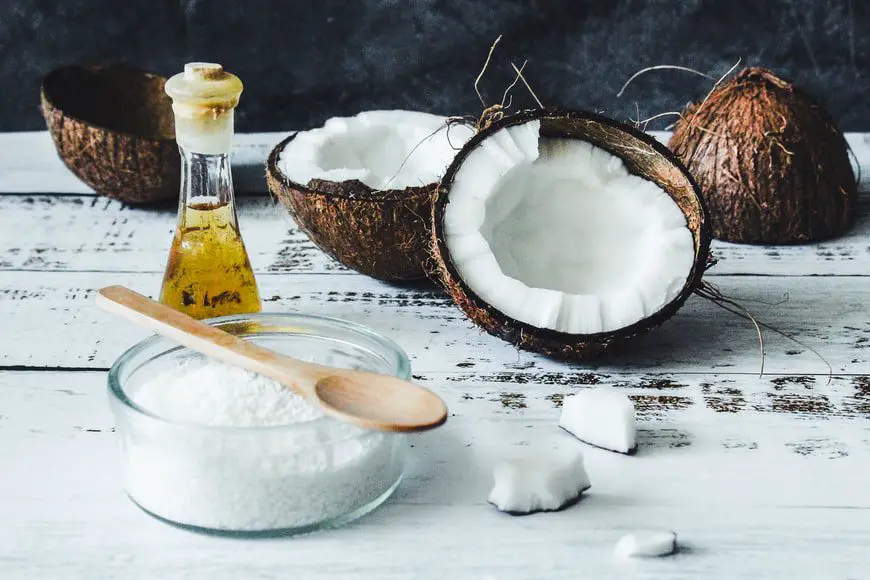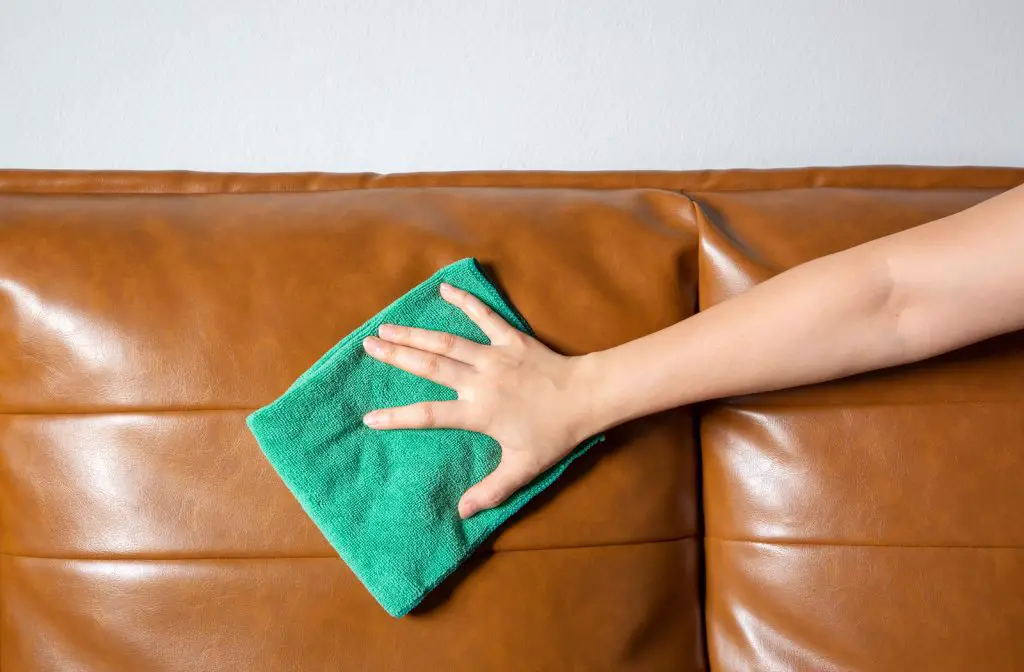You may have heard that conditioner and imitation leather are fantastic to use for coconut oil, they will eliminate the cracks and maintain the leather’s smooth appearance for a long time.
To respond to these queries and others, we looked into whether coconut oil is safe to apply to leather and faux leather.
Coconut oil is an excellent conditioner for leather and fake leather.
Apply the oil to the leather or synthetic leather’s surface with a dry and clean cloth.
In colder climates, coconut oil becomes harder to prevent the coconut oil from hardening on the material, you might need to warm it up before applying it.
However, it can darken the leather, and some people don’t like the way coconut oil smells, so applying coconut oil on leather truly worthwhile?
Therefore, you must read this article in its entirety because I have covered everything you need to know about applying coconut oil to leather.
I’ve also provided some information in case you dislike coconut oil after applying it to the leather, then how do you get rid of it?
Let’s Get Going!
Things to Consider Before Using Coconut Oil on Leather:

Before you begin, consider the following advice:
Type of Leather:
Various leather types exist, including full-grain, top-grain, and corrected-grain.
The toughest and most resilient leather is full-grain, while the rectified grain is the least durable.
Leather condition:
Another thing to consider is the condition of your leather.
If the leather is already damaged, you might want to avoid applying coconut oil since it could make things worse.
Safety:
Before applying coconut oil to the entire piece, try it on a tiny, discrete section of the leather.
This will assist you in preventing any possible harm to the leather.
5 Simple Steps for Applying Coconut Oil on Leather!
Coconut oil is a good choice if you want to give your leather apparel or furnishings a little more shine and protection.
Here is a quick 5-step guide for applying coconut oil to leather:
1. Leather Surface Cleaning:

Cleaning the leather surface on which you will be putting the coconut oil is the first step.
This will assist in clearing away any debris that can hinder the oil’s ability to absorb.
Use a gentle, dry cloth and stay away from any harsh chemicals or cleaners to prevent damaging the leather.
However, you can substitute white vinegar diluted with water if the leather is too soiled.
2. Apply a small amount of coconut oil onto a clean cloth:

To prevent getting any dirt or other debris on your leather, be sure to use a clean towel.
A modest amount of oil should be poured onto the cloth as well.
If more is required, you can always apply but after you’ve applied too much oil it might be challenging to get it off.
Start a little and increase it gradually as coconut oil is solid at room temperature, it must be slightly warmed before use.
Avoid melting or overheating the oil as doing so can harm the leather.
It’s recommended to test the oil on a small, concealed area before rubbing it onto the full leather piece because every leather piece is unique.
3. Circularly rub the oil into the leather surface:

Being a natural substance, leather can absorb other natural oils including coconut oil.
To get the most out of your conditioning treatment, work the oil into the leather surface in a circular motion.
This will facilitate the oil’s equal distribution and substance penetration.
Given that leather is porous and crucial to use a lot of oil so that it can effectively penetrate the material and perform its function.
It’s also essential to be patient and take your time during this phase to prevent streaks or clumps.
4. Wipe Away Extra Oil with A Clean Cloth:

Rub the oil into the leather and wipe off any excess with a fresh cloth.
You don’t want to leave behind a greasy film, so remove any oil that isn’t being absorbed by the leather.
Since coconut oil is solid at room temperature, any excess is easily removed with a cloth.
It will quickly seep into the leather, so you don’t need to worry about taking a very long time to dry.
If the oil is still wet, use a hairdryer on the cool setting to speed up the process.
As long as you don’t go overboard, this will aid in the oil’s equal distribution and protect the leather from damage.
5. Let the oil penetrate the leather:

As a natural conditioner, coconut oil will aid in softening and preserving your leather.
The effects will be better and longer as you give it time to take effect.
Just make sure to remove any extra oil that doesn’t absorb.
The fact, if there is an excessive amount of surface dust, it may attract it and the best strategy is to softly apply a small amount.
The excess can be removed with a soft cloth if you accidentally use too much.
Coconut oil shouldn’t be used on suede leather.
Suede is a sensitive material that can be damaged by oil.
Advantages of Coconut Oil as a Leather Conditioner:
For naturally conditioned leather items, use coco oil.
It can aid in preserving, softening, and shielding your leather goods from the outdoors.
The advantages of coconut oil on leather items are as follows:
1. Softens Leather:
Products made of leather that feel stiff and dry can be conditioned and softened with coconut oil.
Still, it’s crucial to remember that too much oil might make leather sticky, so keep that in mind.
2. Restore Damaged Condition:
The leather may deteriorate and split with time due to exposure to the sun, wind, and rain.
Its condition can be improved and given new life by coating it in coconut oil.
3. Water Resistant:
Leather is shielded from moisture and stains by a water-resistant layer that coconut oil helps to build.
Since it is a natural oil unlike other synthetic conditioners, it won’t harm or dry up the leather.
4. Avoid UV Rays:
Leaving leather in the sun’s direct rays poses the greatest risk.
The leather will quickly crack and fade due to UV light.
However, you can shield your leather goods from the sun’s damaging rays by coating them with a small layer of coconut oil.
Disadvantages of Coconut Oil as a Leather Conditioner:
The natural process of tanning animal skins or hides yields leather.
It is utilized to create a range of goods, such as apparel, accessories, and furniture.
Before using coconut oil on leather, consider the drawbacks as follows:
1. Draw Dust and Dirt:
The oil can attract dirt and dust, which will quickly make your leather item appear dirty.
As a result, applying coconut oil to leather will require more frequent cleaning.
2. Make Leather Stiff:
Coconut oil may cause your leather to feel stiffer and less malleable because the oil may prevent the leather from being able to “breathe,” clogging its pores.
3. Change The Colour and Appearance:
Some individuals might like how coconut oil darkens and alters the appearance of leather, but others might not.
It is important to try the oil first in a discreet location if you are unsure of how your leather will respond to it.
How Can Coconut Oil Be Removed from Leather?
There are a few various techniques you might employ if you need to remove coconut oil from leather.
- The first is to use a solvent such as acetone or alcohol.
- Using a degreaser like a dish soap or laundry detergent is an additional choice.
- A poultice consisting of flour or corn starch might also be used; whatever strategy you choose, make sure to test it first in a stealthy setting.
- If using a clean cloth, dash it with the solvent and rub the affected area in a circular motion.
- You might need to carry out this procedure more than once to get rid of the oil completely.
- If using a degreaser, apply it to a cloth and rub the afflicted area in a circular motion.
- Afterwards, make sure to thoroughly clean the area.
- It is advised to avoid applying coconut oil on light-coloured leather because it can darken leather.
- If you have to use it on light-coloured leather, make sure to condition it immediately.
FAQ: Can You Use Coconut Oil on Leather?
Q1. How Much Coconut Oil Should You Use on Leather?
If you over-oil the leather with coconut oil, the fibres will eventually begin to deteriorate.
This may cause the leather to deteriorate and age prematurely.
Q2. How Usually Should You Use Coconut Oil to Condition Leather?
It truly depends on how much the leather is handled and how much dirt and exposed sunlight.
Once a week ought to be adequate if you use your leather goods every day.
Q3. What makes using coconut oil on leather different from using other types of oils?
Natural leather conditioners and protector coconut oil have been used for millennia.
It works well on all types of leather including saddles, bridles, and other horse equipment.
Additionally, it works well with aniline, conditioned, and unfinished leather.
Although other oils can be applied to leather, they are less reliable and secure.
Conclusion:
Natural coconut oil offers numerous advantages for leather, it keeps the leather moisturized, supple, and fresh-looking.
Although there are certain refusals to using coconut oil on leather, you can prevent them from this natural substance by following a few easy measures.
It is crucial to take into account the steps you must take before applying coconut oil to leather, such as ensuring the surface is clear of dust and debris.
Enjoy your leather products‘ new shine by applying coconut oil to them using these easy procedures!
If you have any queries, feel free to post them in the comments section below.
Section Under: How To










